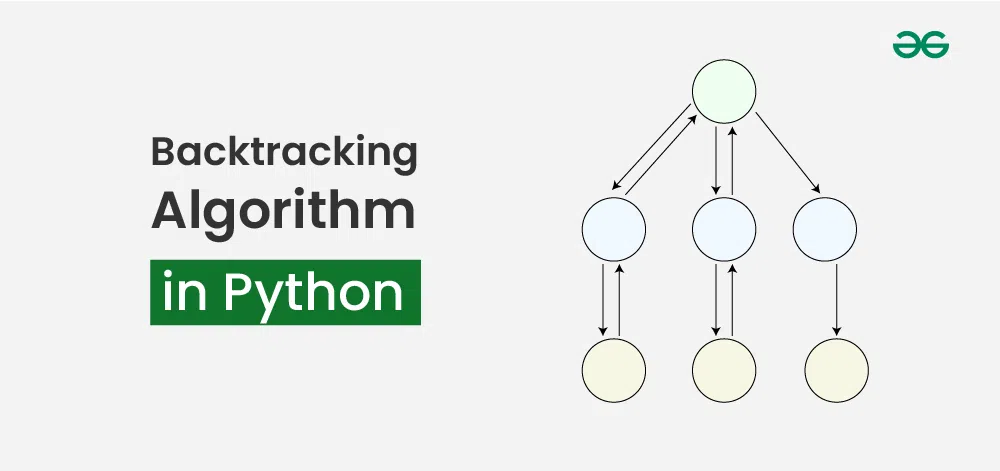Backtracking Algorithm in Python
Last Updated :
03 Jun, 2024
Backtracking is a problem-solving algorithmic technique that involves finding a solution incrementally by trying different options and undoing them if they lead to a dead end. The backtracking algorithm is a recursive algorithm that is used to solve problems by making a series of choices, and if a choice leads to a dead end, it backtracks to the last valid choice made and tries a different path. It is often used to solve problems such as the N-Queens puzzle, Sudoku, and the Knight's Tour.

How Does a Backtracking Algorithm Work?
A backtracking algorithm works by recursively exploring all possible solutions to a problem. It starts by choosing an initial solution, and then it explores all possible extensions of that solution. If an extension leads to a solution, the algorithm returns that solution. If an extension does not lead to a solution, the algorithm backtracks to the previous solution and tries a different extension.
The following is a general outline of how a backtracking algorithm works:
- Choose an initial solution.
- Explore all possible extensions of the current solution.
- If an extension leads to a solution, return that solution.
- If an extension does not lead to a solution, backtrack to the previous solution and try a different extension.
- Repeat steps 2-4 until all possible solutions have been explored.
Pseudocode:
function backtracking(state):
if state is a solution:
return state
for choice in all possible choices:
if choice is valid:
make choice
result = backtracking(state with choice)
if result is not failure:
return result
undo choice
return failure
It is commonly used in situations where you need to explore multiple possibilities to solve a problem, like searching for a path in a maze or solving puzzles like Sudoku. When a dead end is reached, the algorithm backtracks to the previous decision point and explores a different path until a solution is found or all possibilities have been exhausted.
Example of Backtracking Algorithm:
Implement the Backtracking algorithm to solve the N-Queens problem in Python.
Examples:
Input:
N = 4
Output:
[ [".Q..", "...Q", "Q...", "..Q."],
["..Q.", "Q...", "...Q", ".Q.."] ]
Input:
N = 1
Output: [ ["Q"] ]
Step-by-step algorithm:
- Initialize an empty chessboard of size
N x N. - Start placing queens on the chessboard, one column at a time.
- Before placing a queen in a column, check if it is safe to place the queen in that position.
- If the queen can be placed safely, proceed to the next column recursively.
- If no safe position is found, backtrack to the previous column and try the next position.
- Repeat the process until all queens are placed on the chessboard or all possibilities are explored.
Below is the implementation of the above idea:
Python
def is_safe(board, row, col, N):
# Check this row on the left side
for i in range(col):
if board[row][i] == 'Q':
return False
# Check upper diagonal on left side
for i, j in zip(range(row, -1, -1), range(col, -1, -1)):
if board[i][j] == 'Q':
return False
# Check lower diagonal on left side
for i, j in zip(range(row, N, 1), range(col, -1, -1)):
if board[i][j] == 'Q':
return False
return True
def solve_n_queens(N):
board = [['.' for _ in range(N)] for _ in range(N)]
result = []
def backtrack(board, col):
if col == N:
result.append([''.join(row) for row in board])
return
for i in range(N):
if is_safe(board, i, col, N):
board[i][col] = 'Q'
backtrack(board, col + 1)
board[i][col] = '.'
backtrack(board, 0)
return result
# Example 1
N1 = 4
result1 = solve_n_queens(N1)
print(f"Solution for Example 1 with N = {N1}:")
for solution in result1:
print(solution)
print()
# Example 2
N2 = 1
result2 = solve_n_queens(N2)
print(f"Solution for Example 2 with N = {N2}:")
for solution in result2:
print(solution)
OutputSolution for Example 1 with N = 4:
['..Q.', 'Q...', '...Q', '.Q..']
['.Q..', '...Q', 'Q...', '..Q.']
Solution for Example 2 with N = 1:
['Q']
Time Complexity: O(N!)
Auxiliary Space: O(N2)
Similar Reads
Top 20 Backtracking Algorithm Interview Questions Backtracking is a powerful algorithmic technique used to solve problems by exploring all possible solutions in a systematic and recursive manner. It is particularly useful for problems that require searching through a vast solution space, such as combinatorial problems, constraint satisfaction probl
1 min read
A* Search Algorithm in Python Given an adjacency list and a heuristic function for a directed graph, implement the A* search algorithm to find the shortest path from a start node to a goal node. Examples: Input:Start Node: AGoal Node: FNodes: A, B, C, D, E, FEdges with weights:(A, B, 1), (A, C, 4),(B, D, 3), (B, E, 5),(C, F, 2),
8 min read
Searching Algorithms in Python Searching algorithms are fundamental techniques used to find an element or a value within a collection of data. In this tutorial, we'll explore some of the most commonly used searching algorithms in Python. These algorithms include Linear Search, Binary Search, Interpolation Search, and Jump Search.
6 min read
Introduction to Backtracking Backtracking is like trying different paths, and when you hit a dead end, you backtrack to the last choice and try a different route. In this article, we'll explore the basics of backtracking, how it works, and how it can help solve all sorts of challenging problems. It's like a method for finding t
7 min read
Backtracking meaning in DSA Backtracking can be defined as a general algorithmic technique that considers searching every possible combination in order to solve a computational problem. Backtracking simple structure is shown like the following: Structure of BacktrackingProperties of Backtracking:Incremental construction: Backt
3 min read